The world of designer dogs is ever-expanding, and the Lhasapoo is a charming newcomer that’s quickly capturing hearts. This delightful mix combines the loyal and protective nature of the Lhasa Apso with the intelligence and playful personality of the Poodle. The result? A small-sized pup that’s perfect for apartment living!
But the Lhasapoo’s appeal goes beyond size. These hypoallergenic dogs are a dream come true for allergy sufferers. Their non-shedding coat minimizes cleanup, and their highly trainable nature makes them a joy to have around. While not the most common designer breed, Lhasapoos boast a long lifespan and a friendly temperament that makes them wonderful companions for families with kids and other pets.
What is a Lhasapoo
Imagine a dog that combines the playful energy of a poodle with the regal air of a Lhasa Apso. That’s the Lhasapoo, a charming designer dog breed that’s quickly becoming a favorite among pet lovers.
These adorable pups are a cross between the miniature poodle, known for its intelligence and hypoallergenic coat, and the Lhasa Apso, a small breed originating from Tibet. Lhasa Apsos were once revered in the Orient, considered sacred companions to monks and even seen as symbols of good fortune. Their long, flowing silky coats were a sign of their importance.
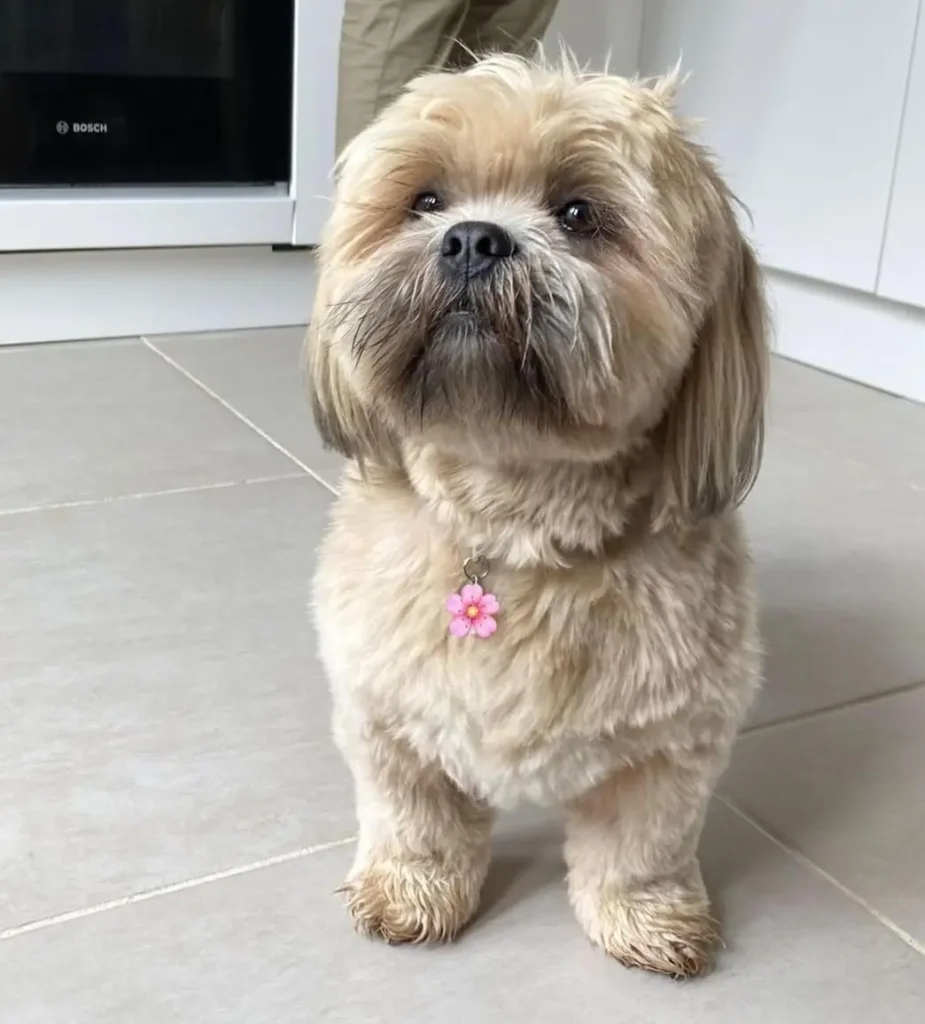
Fast forward to the 19th century, and the miniature poodle’s popularity as a house pet soared. Breeders saw an opportunity to combine these two breeds, resulting in the Lhasapoo we know today. These compact pups come in a variety of colors and often inherit the hypoallergenic coat of the poodle, making them a great choice for allergy sufferers.
Designer Dog Breed Mix
Lhasapoos, a charming mix of Lhasa Apsos and Poodles, are quickly becoming popular companions. While not recognized as a distinct breed by major kennel clubs, these designer dogs are stealing hearts with their adorable appearance and playful personalities.
Think of them as furry bundles of joy, inheriting a delightful variety of traits from their parents. Lhasapos inherit their intelligence and trainability from the Poodle side, while the Lhasa Apso influence brings a touch of independence and alertness. The result? A smart and curious pup that thrives on attention and playtime.
Unveiling the Lhasa Poo: A Look at Their Adorable Appearance
The Lhasa Poo is a captivating mix of two beloved breeds, the Lhasa Apso and the Poodle. This playful pup inherits a charming look that can vary depending on which parent breed’s traits shine through. Let’s delve into the world of Lhasa Poo appearances, exploring their coat types, color variations, size, and other endearing features.
A Coat of Many Colors: Exploring the Lhasa Poo’s Fur
The Lhasa Poo’s coat is a charming surprise, a delightful mix inherited from its mom and dad. Here’s what makes their fur so special:
- Curly, Wavy, or Somewhere In-Between: Just like flipping a coin, you never quite know what kind of coat a Lhasa Poo will get! Some pups inherit the Poodle’s signature curls, while others rock the long, flowing locks of the Lhasa Apso. Many even land somewhere in between with a beautiful wavy coat.
- A Rainbow of Colors: Lhasa Poos come in a delightful array of colors! Popular choices include solid colors like black, white, cream, apricot, gold, brown, and red. You might even find Lhasa Poos with a combination of these colors and white markings, called parti-colors.
- Minimal Shedding, Big Joy for Allergies: Thanks to the Poodle’s influence, Lhasa Poos are known for minimal shedding, making them a great choice for allergy sufferers. But remember, even low-shedding pups need regular brushing to keep their fur tangle-free.
Finding Your Perfect Fit: Lhasapoo Size
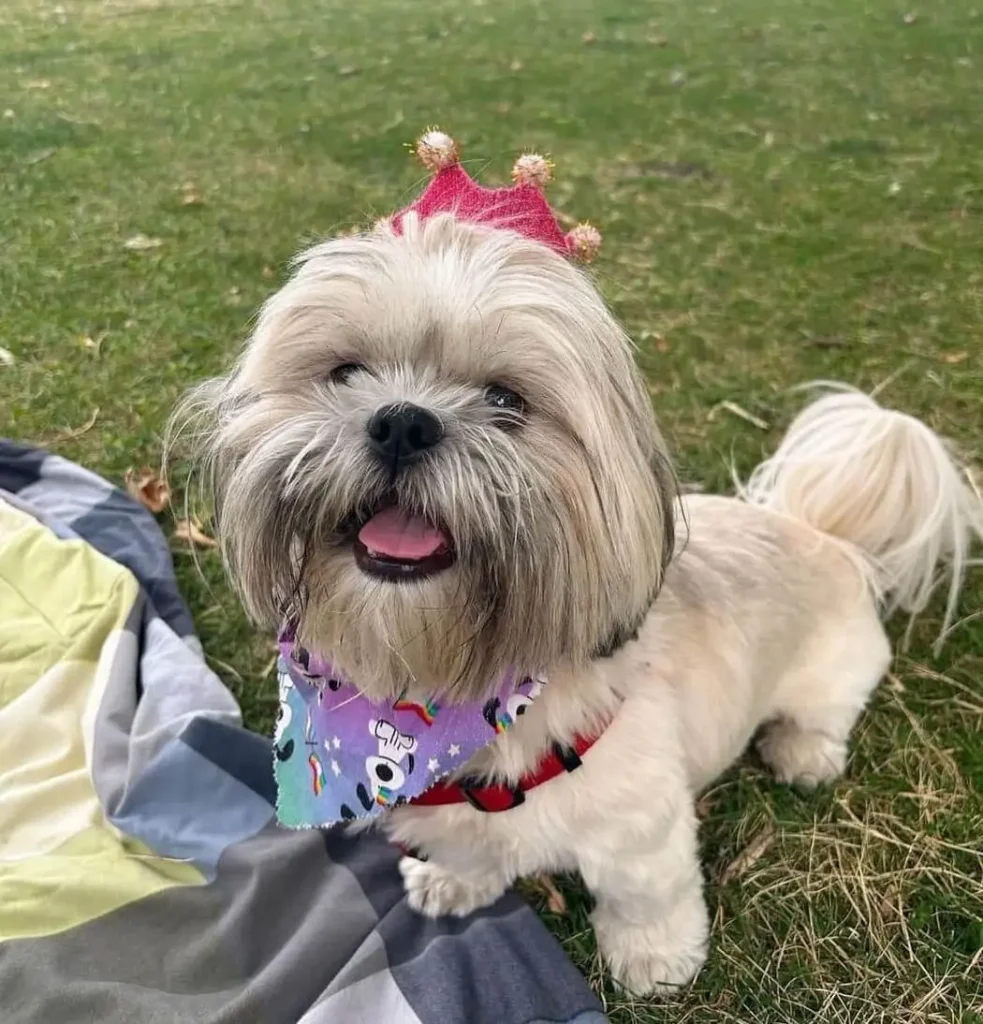
The size of your Lhasapoo depends on the type of Poodle used in the breeding. Miniature Poodles contribute to a smaller Lhasapoo, while Standard Poodles can result in a slightly larger dog.
Small But Mighty
Generally, Lhasapoos are considered small to medium-sized dogs. Their weight typically ranges from a manageable 10 to 20 pounds. Don’t let their size fool you, though! Lhasapoos are full of personality and energy.
Standing Tall
When it comes to height, you can expect your Lhasapoo to stand between 10 and 20 inches at the shoulder. This makes them perfect for cuddling on the couch or joining you for a walk without feeling like you’re walking a giant breed.
Other Physical Characteristics
Eyes & Expression: Lhasapoos typically have round, dark eyes that brim with alertness and intelligence. This soulful gaze, combined with their floppy ears, gives them an irresistibly sweet expression.
Head & Muzzle: Their head is well-proportioned to their body, and they inherit the Lhasa Apso’s slightly elongated muzzle. The nose pad is usually black, adding a touch of contrast to their face.
Tail & Fur: The tail is another interesting feature. Held high and often plumed with fur, it can add a touch of elegance to their overall look. Speaking of fur, Lhasapoos can have either the long, flowing coat of a Lhasa Apso or the curly, hypoallergenic coat of a Poodle.
Lhasa Poo Personality: Playful, Smart, and Loyal Companions
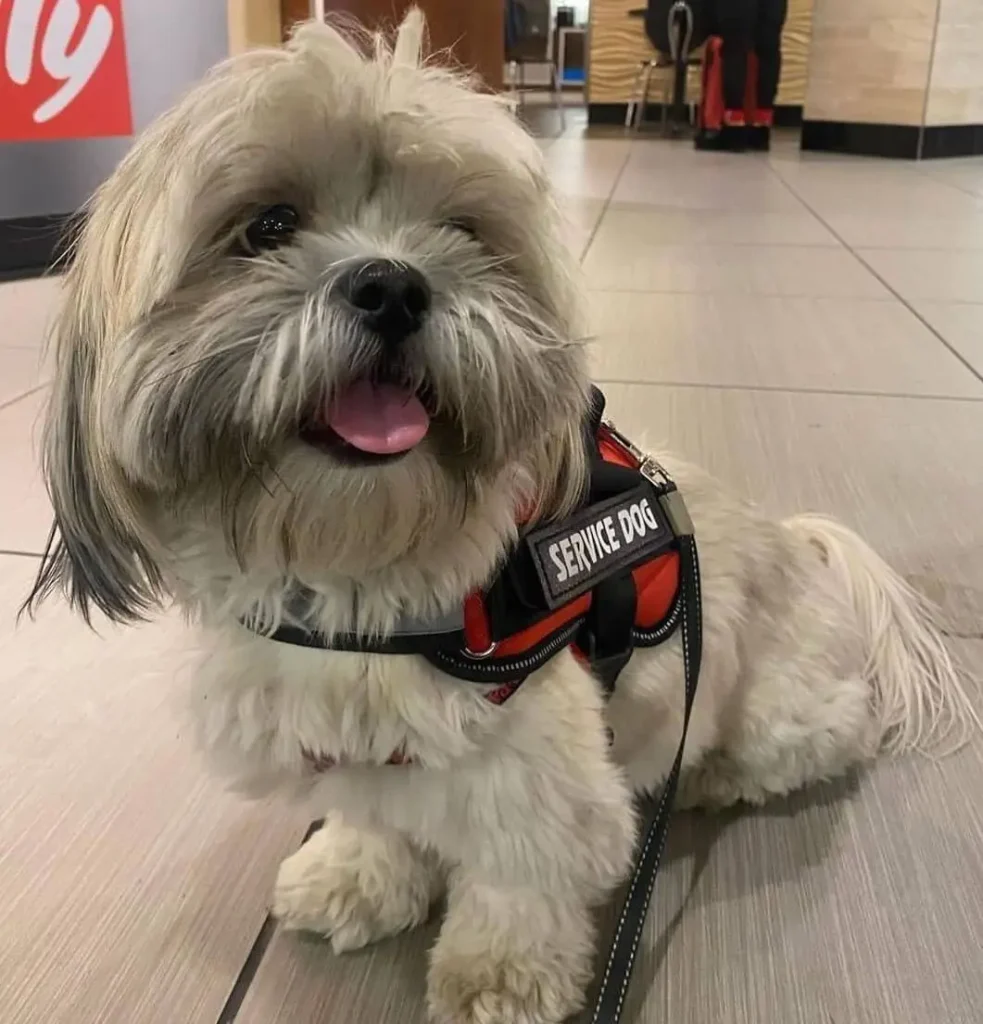
The Lhasa Poo inherits a delightful blend of personality traits from both the Lhasa Apso and the Poodle, making them charming companions. Here’s a closer look at what you can expect:
Personality Traits
- Playful: Lhasa Poos are known for their playful and energetic spirit. They love games, walks, and engaging activities that keep their minds and bodies active.
- Intelligent: Both parent breeds are known for their intelligence, and Lhasa Poos follow suit. They are quick learners and eager to please, making them highly trainable.
- Loyal: These pups form strong bonds with their families and shower them with affection. They are devoted companions who will be by your side for all your adventures.
Trainability
Lhasa Poos inherit a good dose of trainability from both parent breeds. Poodles are known for their eagerness to learn and ability to follow commands, while Lhasa Apsos can be a bit more independent. Here’s what to keep in mind:
- Positive Reinforcement: The key to successful training with Lhasa Poos is positive reinforcement. Reward good behavior with treats, praise, and playtime. This approach will keep them motivated and engaged in the learning process.
- Potential Stubbornness: Lhasa Apso influence can sometimes lead to a stubborn streak in Lhasa Poos. However, their intelligence and desire to please usually outweigh this. Be patient, consistent, and offer plenty of positive reinforcement to overcome any stubborn moments.
Overall, Lhasa Poos are highly trainable with the right approach.
Good Fit for Families/Apartments
Lhasa Poos can be a great fit for families and apartments with some considerations:
- Energy Level: While playful, Lhasa Poos generally have a moderate energy level. Daily walks, playtime, and interactive toys will keep them happy and stimulated. Their smaller size makes them well-suited to apartment living as long as they get their exercise needs met.
- Size: Lhasa Poos are a small to medium-sized breed, making them adaptable to various living situations. They don’t require a huge backyard but will benefit from dedicated playtime indoors or in a manageable outdoor space.
Here’s a quick summary:
- Families: Lhasa Poos can thrive in families with older children who can play gently with them. Supervise interactions with younger children to ensure the safety of both the pup and the child.
- Apartments: Lhasa Poos adapt well to apartments due to their size and moderate energy levels. Just be sure to provide them with daily walks and engaging activities to prevent boredom.
Lhasa Poo Care Made Easy: Grooming, Exercise, and Lifespan
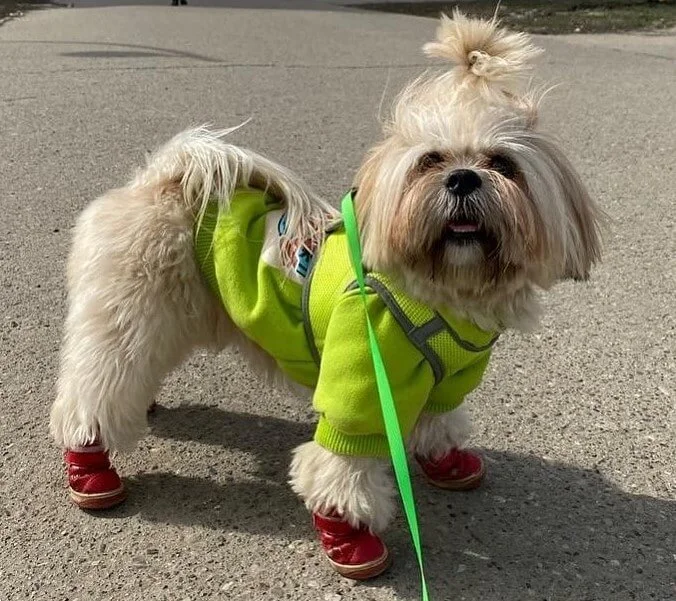
Keeping your Lhasa Poo happy and healthy involves providing them with proper care. Here’s a breakdown of their grooming needs, exercise requirements, potential health concerns, and lifespan.
Grooming Needs
The Lhasa Poo’s coat requires regular attention to prevent matting and maintain its beauty. Here’s what to keep in mind:
- Brushing frequency: Brush your Lhasa Poo’s coat at least 2-3 times a week, and ideally daily. This removes loose hair, prevents tangles, and distributes natural oils for a healthy shine.
- Haircut recommendations: Regular haircuts are recommended every 4-6 weeks to keep the coat manageable and prevent matting. Discuss options with a professional groomer to find a style that suits your preferences and your dog’s needs. Some popular choices include the puppy cut (short all over) or a teddy bear cut (slightly longer on the head and body).
Exercise Requirements
Lhasa Poos inherit a moderate energy level from both parent breeds. They enjoy playtime but don’t require excessive exercise. Here’s a good balance:
- Daily walks: Aim for at least one daily walk of 20-30 minutes to fulfill their exercise needs.
- Playtime: Engage your Lhasa Poo in active playtime indoors or outdoors. Games of fetch, puzzle toys, and playtime in a secure dog park are great options.
- Indoor activities: These pups are adaptable and can get exercise through indoor activities like playing fetch with a ball or interactive toys that stimulate their minds and bodies.
Regular walks and playtime will keep your Lhasa Poo physically and mentally stimulated.
Potential Health Concerns
Like all breeds, Lhasa Poos can be prone to certain health conditions. Here are some common concerns in Lhasa Apsos and Poodles to be aware of:
- Joint problems: Luxating patellas (slipping kneecaps) and hip dysplasia are potential concerns. Regular exercise and maintaining a healthy weight can help reduce the risk.
- Eye problems: Conditions like cataracts and progressive retinal atrophy can occur in Lhasa Apsos and Poodles. Regular vet checkups can help with early detection and management.
- Ear infections: Floppy ears, like those commonly found in Lhasa Poos, can be prone to infections. Regular cleaning and proper drying are essential.
It’s important to note that this is not an exhaustive list. Always consult your veterinarian for comprehensive advice on your Lhasa Poo’s specific health needs.
Lifespan
Lhasa Poos are generally healthy dogs with a lifespan of 12-15 years. Providing them with proper nutrition, regular veterinary care, and a loving environment will contribute to a long and happy life.
Bringing Home Your Lhasa Poo: Breeders, Rescues, and Choosing the Perfect Pup
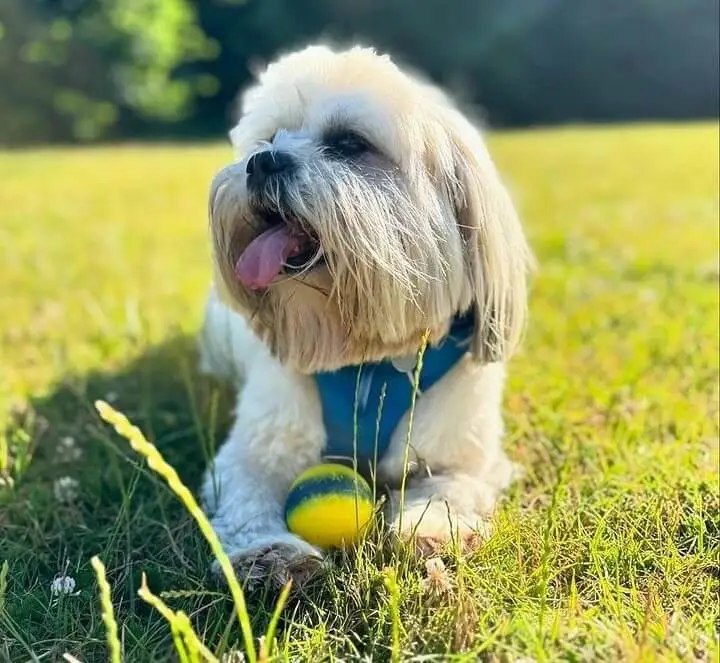
Finding your perfect Lhasa Poo companion involves making an informed decision. Here’s a breakdown of two common routes: reputable breeders and shelters/rescues.
Reputable Breeders vs. Shelters/Rescues
Reputable Breeders:
- Advantages:
- Higher chance of finding a Lhasa Poo with specific breed characteristics (coat type, color).
- Breeders often perform health screenings on parent dogs, potentially reducing the risk of certain health issues in puppies.
- Breeders can provide information about the puppy’s lineage and temperament.
- Disadvantages:
- Lhasa Poo puppies from reputable breeders can be expensive.
- Waiting lists for specific traits or colors may exist.
- Unethical breeding practices can occur, so careful research is crucial.
Shelters/Rescues:
- Advantages:
- You’ll be giving a loving home to a dog in need.
- Adoption fees are typically much lower than purchasing from a breeder.
- Many shelters/rescues provide temperament testing and information about the dog’s background (if available).
- Disadvantages:
- Finding a purebred Lhasa Poo may be more challenging.
- The dog’s history and health background might be unknown.
- Some shelters/rescues may have adoption restrictions or waitlists.
Choosing the Right Path for You:
Both reputable breeders and shelters/rescues offer wonderful opportunities to find a Lhasa Poo. Consider these factors when making your decision:
- Budget: Breeder puppies are generally more expensive than adoption fees.
- Lifestyle: Do you have a preference for a puppy or an adult dog?
- Breed Specificity: How important is it for you to find a purebred Lhasa Poo?
- Time Commitment: Be prepared to research breeders or shelters thoroughly.
Here are some additional tips:
Reputable Breeders: Ask for references, visit their facilities, and ensure they prioritize the health and well-being of their dogs.
Shelters/Rescues: Inquire about their adoption process, the dog’s temperament, and any known health concerns.
No matter which path you choose, make sure you’re comfortable with the source and confident that you can provide a loving and responsible home for your new Lhasa Poo companion.
Conclusion
So, what’s the verdict on Lhasa Poos? These charming pups are a delightful mix of playful personality and adorable looks. Their coat can be curly or wavy, and they come in a variety of fun colors! Lhasa Poos are typically on the smaller side, making them adaptable to different living situations.
While they require regular brushing and playtime, Lhasa Poos are generally easy to care for. Most importantly, they are intelligent and eager to please, making them wonderful companions for families or individuals seeking a loyal and loving friend. If you’re looking for a furry buddy to brighten your days, a Lhasa Poo might just be your perfect match!
Additional Resources
Want to delve deeper into the world of Lhasa Poos? Here are some helpful resources:
Lhasa Apso Breeder Associations:
- Learn more about the Lhasa Apso parent breed and find reputable breeders through these organizations:
Poodle Breeder Associations:
- Explore information about Poodles (typically Miniature Poodles are bred with Lhasa Apsos for Lhasa Poos) and find responsible breeders through these resources:
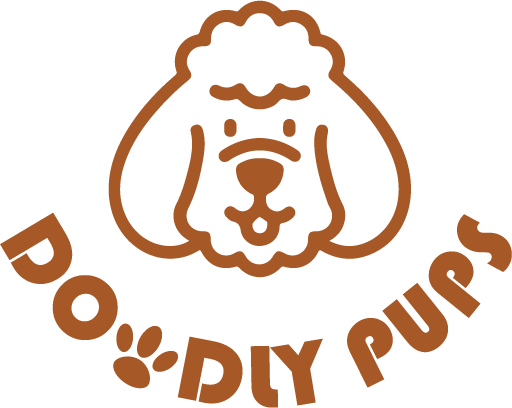
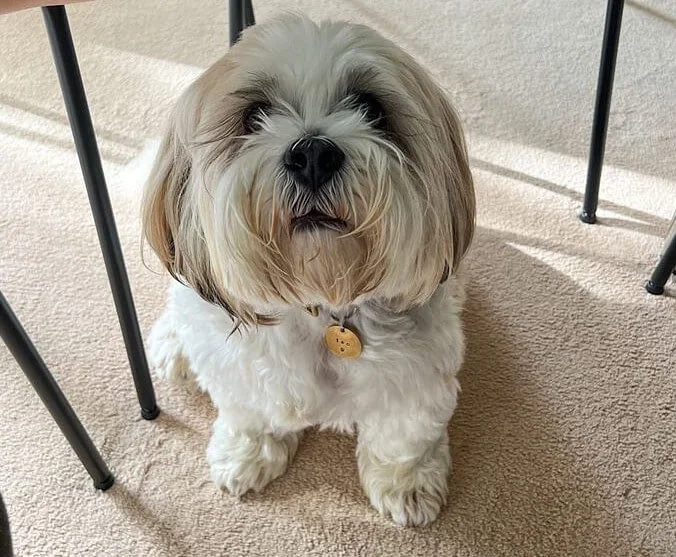

1 thought on “Lhasa Apso Poodle Mix: The Adorable Lhasapoo”